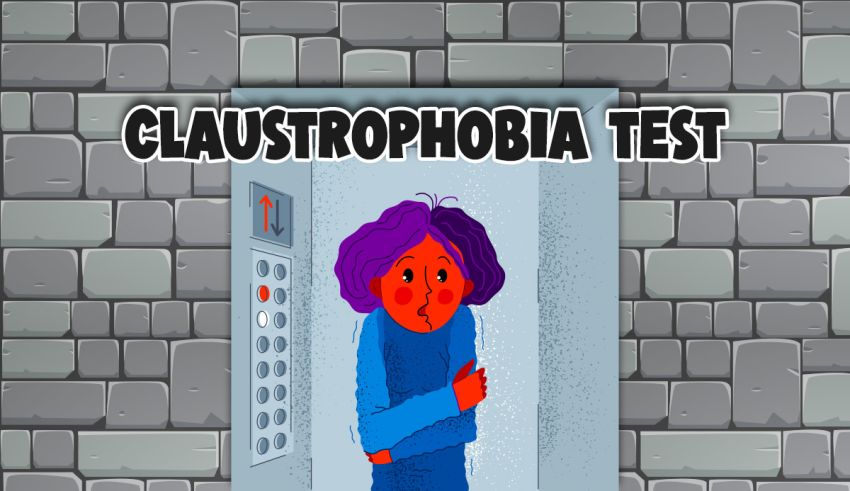Are you afraid of small spaces? This trigger-free claustrophobia test correctly determines whether you are scared of small and enclosed spaces by examining 20 symptoms.
Explanation of the Claustrophobia Test
Using a series of psychological inquiries, you can determine whether you have a fear of confined spaces.
Notably, the questions are 100 percent safe and do not contain any triggering imagery, much as our trypophobia test.
Here, the main objective is to reveal your phobia by examining four important factors.
the signs
The test looks for any indications that you could be terrified of small spaces.
The most typical claustrophobic symptoms, according to NHS, include shaking, sweating, hot flushes or chills, difficulty breathing, a choking sensation, a rapid heartbeat, chest pain or a feeling of constriction in the chest, and stomach butterflies.
• Experiential
Trauma is one of the main reasons of claustrophobia, according to psychologists. In order to determine whether you have a phobia, the test gathers information about your distressing or painful experiences.
in genetics
You are affected by having relatives who have specific phobias. People who have claustrophobic parents are thought to be more susceptible to developing the same illness. As a result, the test also considers your genetics to enhance the outcomes.
Similar fears
According to studies, acrophobia, or a fear of heights, and claustrophobia may be associated. The latter situation causes people to overestimate vertical space, while the former condition causes them to underestimate horizontal space. In order to uncover any associations between your emotions and phobias, we added a few more questions.
What You Discover by Taking the Test
The goal of our editors was to avoid giving you a yes-or-no choice. The outcomes thus contain a number of additional details that may be of interest to you. Here is everything you need to know.
The question “Are you claustrophobic?” has an answer.
The purpose of the questionnaire is to determine whether you have a fear of small or enclosed spaces. We compiled a database of the signs, feelings, and ways of thinking that claustrophobic patients use to describe their symptoms. Your responses enable us to accurately profile you by comparing the data to the database.
Check to see if you suffer from cleithrophobia or claustrophobia.
The claustrophobia test is important because it can distinguish between cleithrophobia and a fear of small spaces. The former is worry brought on by being in a certain place, whereas the latter is fear of a situation. Cleithrophobia People experience fear and menace when confined in a space, regardless of its size. However, those with claustrophobia only experience panic when the space is extremely small or congested.
Your degree of claustrophobia.
According to science, there are no distinct varieties of claustrophobia. However, based on the triggers, people categorize the dread into different groups. For instance, a fear of elevators, restrooms, buses, or flying.
Find out more about your fear and its origins.
While it can be difficult to identify the underlying reason for a fear, our exam makes an effort to do so. You are given a short list of potential causes for your fear of enclosed spaces after completing the questionnaire.
Without a Test, How to Determine If You Have Claustrophobia
The questions below can help you determine whether you have claustrophobia. We still advise using the quiz instead because it’s not an accurate method. However, this is your best option if you’re pressed for time or don’t believe in online tests.
How anxious are you when you are in a small or cramped space?
A phobia is an uncontrollable, illogical fear or worry. So if you only dislike cramped spaces, you can’t claim to be claustrophobic. Extreme signs of the disease include fainting or shortness of breath in the sufferer. To arrive at a trustworthy conclusion, it’s critical to understand how substantial and unbearable your feelings are.
How much effort do you expend to avoid confined or compact spaces?
A phobic individual may go to great lengths to avoid a potentially triggering scenario. For instance, they might choose to take the stairs rather than the elevator to reach the eighth story. In order to answer the question “Am I claustrophobic?” try to reflect on your actions. Do you take every precaution to lessen the likelihood that you will have to confront your fears?
How does your fear impact your daily life, question #3?
Your life may be significantly impacted by claustrophobia, which can make it difficult to complete regular duties. For instance, if you are unable to use the bus or the subway, you may be late for work.
What physical symptoms do you experience?
You are more likely to be claustrophobic if your symptoms are more severe when you are in a compact space. The most frequent ones include heavy perspiration, trembling, chills or hot flushes, shortness of breath, or trouble breathing.
What if the test for claustrophobia revealed that you are afraid?
Not to worry. All people in the globe share a shared phobia of small spaces. And treatment is frequently used to treat it. However, if you’re not yet prepared to begin therapeutic treatment, stick to these guidelines.
Note: Clinical psychologist Dr. Nicole Cain offers advice on overcoming claustrophobia.
Use logic to help you.
You have to struggle to maintain control when the fear and worry appear. You can assist yourself remember the irrational components of your emotions by using reasoning. For instance, flying is the safest mode of transportation. Therefore, you can be logical about the options and concentrate on facts—rather than feelings—when you feel cramped inside one.
Let the drama end.
Your fears become stronger the more you avoid them. Therefore, tackling your claustrophobia should be your next move if you did the test and discovered you have it. The ability to become numb to trigger events must be forced.
Consider items that give you a sense of security.
When you’re feeling triggered, one helpful trick is to recall your favorite moments or the safest places you can think of. It assists your brain in changing its attention and, ideally, forgetting about your fight-or-flight response state.
Keep a claustrophobic toolkit on hand.
You can purchase or manufacture your own kits to help you feel secure. A GPS or flashlight might be included in your bag to create the appearance of security, along with mementos from happy times.
Warning: Before taking the Claustrophobia Test, read this.
People can use the questionnaire on this website to determine whether they have a phobia of small or constrained spaces. It is not a clinical test, like all other online equivalents. However, it is supported by scientific data and claustrophobia facts. So you can trust the outcomes. However, you shouldn’t consider them as a diagnosis’s medical proof. Only a qualified psychiatrist or psychologist can make the diagnosis of excessive fear/anxiety in you.
If you have any inquiries concerning the test or your findings, kindly get in touch with us. We reply to all emails and comments as soon as we can.
For more personality quizzes check this: Claustrophobia Test.





